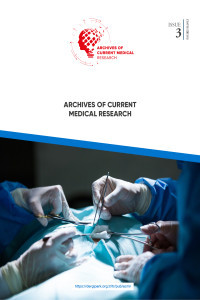Carboxyhemoglobin, Methemoglobin and Lactate Levels in Patients with Systemic Inflammatory Response Syndrome
Carboxyhemoglobin, Methemoglobin and Lactate Levels in Patients with Systemic Inflammatory Response Syndrome
SIRS, Carboxyhemoglobin, Methemoglobin, Lactate.,
___
- 1. Horeczko T, Green JP, Panacek EA. Epidemiology of the Systemic Inflammatory Response Syndrome (SIRS) in the emergency department. West J Emerg Med. 2014;15(3):329-36.
- 2. Comstedt P, Storgaard M, Lassen AT. The Systemic Inflammatory Response Syndrome (SIRS) in acutely hospitalised medical patients: a cohort study. Scand J Trauma Resusc Emerg Med. 2009;17:67.
- 3. Bloom BM, Grundlingh J, Bestwick JP, Harris T. The role of venous blood gas in the emergency department: a systematic review and meta-analysis. Eur J Emerg Med. 2014;21(2):818.
- 4. Slebos DJ, Ryter SW, Choi AM. Heme oxygenase-1 and carbon monoxide in pulmonary medicine. Respir Res. 2003;4(1):7.
- 5. Wennmalm A, Benthin G, Petersson AS. Dependence of the metabolism of nitric oxide (NO) in healthy human whole blood on the oxygenation of its red cell haemoglobin. Br J Pharmacol. 1992;106(3):507-8.
- 6. Kosaka H, Uozumi M, Tyuma I. The interaction between nitrogen oxides and hemoglobin and endothelium-derived relaxing factor. Free Radic Biol Med. 1989;7(6):653-8.
- 7. Schuerholz T, Irmer J, Simon TP, Reinhart K, Marx G. Methemoglobin level as an indicator for disease severity in sepsis. Crit Care. 2008;12(Suppl 2):P448-P.
- 8. Singer AJ, Taylor M, Domingo A, Ghazipura S, Khorasonchi A, Thode HC, Jr., et al. Diagnostic characteristics of a clinical screening tool in combination with measuring bedside lactate level in emergency department patients with suspected sepsis. Acad Emerg Med. 2014;21(8):853-7.
- 9. James JH, Luchette FA, McCarter FD, Fischer JE. Lactate is an unreliable indicator of tissue hypoxia in injury or sepsis. Lancet. 1999;354(9177):505-8.
- 10. de Siqueira ME, Martins I, Costa AC, Andrade EL, Esteves MT, Lima SA. [Reference values for carboxyhemoglobin]. Rev Saude Publica. 1997;31(6):618-23.
- 11. Moncure M, Brathwaite CE, Samaha E, Marburger R, Ross SE. Carboxyhemoglobin elevation in trauma victims. J Trauma. 1999;46(3):424-7.
- 12. Hunter K, Mascia M, Eudaric P, Simpkins C. Evidence that carbon monoxide is a mediator of critical illness. Cell Mol Biol (Noisy-legrand). 1994;40(4):507-10.
- 13. Wright RO, Lewander WJ, Woolf AD. Methemoglobinemia: etiology, pharmacology, and clinical management. Ann Emerg Med. 1999;34(5):646-56.
- 14. Ohashi K, Yukioka H, Hayashi M, Asada A. Elevated methemoglobin in patients with sepsis. Acta Anaesthesiol Scand. 1998;42(6):713-6.
- 15. Nguyen HB, Rivers EP, Knoblich BP, Jacobsen G, Muzzin A, Ressler JA, et al. Early lactate clearance is associated with improved outcome in severe sepsis and septic shock. Crit Care Med. 2004;32(8):1637-42.
- 16. Mikkelsen ME, Miltiades AN, Gaieski DF, Goyal M, Fuchs BD, Shah CV, et al. Serum lactate is associated with mortality in severe sepsis independent of organ failure and shock. Crit Care Med. 2009;37(5):1670-7.
- Yayın Aralığı: Yılda 3 Sayı
- Başlangıç: 2020
- Yayıncı: 14 Mart Tıbbiyeliler Derneği
Ezgi TUNCAY, Mustafa ÖZTÜRK, Ayşenur Nergiz TANIDIR, Burcu SENGÜVEN TOKÖZLÜ, Özge PAŞAOĞLU
Factors Affecting the Nutritional Habits of Cerebral Palsy Patients
Merve ÇALKIN KORKMAZ, Mehmet AĞIRMAN, Elif AY
Mehmet Ali CEYHAN, Miray TÜMER, Selahattin GÜRÜ, Gültekin KADI, Gültekin Günhan DEMİR
Mehmet Cenk TURGUT, Serdar TOY, Mehmet KÖSE, Muhammed Çağatay ENGİN
Renal Epithelioid Angiomyolipoma with Aggresive Progression: A Case Report and Literature Review
Emre ALTINTAŞ, Ali Furkan BATUR, Mehmet KAYNAR, Murat GÜL, Murat AKAND, Serdar GÖKTAŞ, Zeliha ÇELİK, Özcan KILIÇ
Skin Findings Related to COVID-19, the Review of the Current Literature
Unexpected Arrhythmia in a Young Patient: Hookah Smoking Triggered Atrial Fibrillation
Muhammed KESKİN, Tufan ÇINAR, Murat SELÇUK, Selami DOĞAN, Vedat ÇİÇEK, Ahmet Lütfullah ORHAN
Selahattin GÜRÜ, Gültekin KADI, Begüm ÖKTEM, Mehmet KARAMERCAN
Comparison of Suture-Button Versus HookPlate Fixation for Acromioclavicular Joint Injuries
Osman Yağız ATLI, Hüseyin Bilgehan ÇEVİK, Hakan ASLAN, Evrim DUMAN
